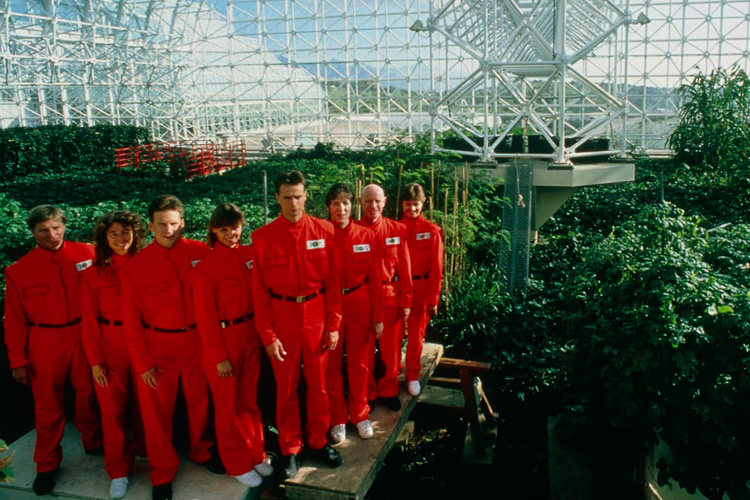If you’ve been to Oracle, Arizona, you’ve probably visited the Biosphere 2 research facility (is there any other reason to be in Oracle?). For those who are too young or far off to remember Biosphere 2, here’s the lowdown: in the 1980s, scientists were starting to worry about climate change (those silly alarmists) and researching ways for humans to survive an uninhabitable Earth. One possibility was moving to another planet, but to do that, we’d need to create Earth-like conditions somewhere that humanity wasn’t meant to thrive—so researchers built a prototype mini-Earth in the Arizona desert. That’s Biosphere 2 (biosphere 1 being Earth, for now). Spaceship Earth, a new documentary that’s available for home rental, is about the people who put it together.
And the people who lived in it: as part of an experiment to see if humans could handle sustaining an artificial Earth, a team of eight people lived in Biosphere 2 for two years, from September 1991 to September 1993. Their goals were to take care of the biosphere’s subsystems—rainforest, ocean, wetland, grassland, desert, and farmland, all inside a big glass building—and not kill each other in the process. The experiment didn’t go as planned (commendable lack of murder, though), and its failure has lived in relative infamy since.
Documentarian Matt Wolf dabbles in diagnosing the experiment’s downfall, but his Spaceship Earth starts the story in 1966, when Kathelin Gray met John Allen. Before they were pioneers of the Biosphere 2 project, they were young dreamers who lived across the hall from each other in San Francisco. The day they met, they decided to start a commune, and gathered a small group of friends to decide what their communal discipline would be. After proving unable to pick between theater, art, business, and science, the group settled on a compromise: all of them.
And oh, the places they’d go. The commune really did do it all: they founded a theater collective, maintained a self-sustaining farm, built a ship from scratch and toured around the world, restored a hotel in Nepal and started an art gallery in London and contributed to prestigious scientific panels—whatever your dream is, they probably did it. The first half hour of Spaceship Earth follows their pre-Biosphere journey exclusively, and at the risk of trivializing the documentary’s namesake, it’s probably the most fascinating portion of the film.
This partly comes down to the passion with which the doc’s subjects discuss that time of their lives. When the topic of the interviews turns to Biosphere 2, these people are recalling their most famous failure, and their tone is tinged with reservation and regret. But when they’re sharing stories from their early years: fire in their hearts, craving in their bellies, nostalgia for an incredible adventure. Veteran doc editor David Teague stitches together footage from these years without losing its improvisational voice, opening a window into a life that most of us can only daydream of. It’s an affective tribute to the power of collective action, whisking you away in the arms of philosopher kings.
When Spaceship Earth switches gears to Biosphere 2, it’ll hold your attention because the history is interesting, but it loses some of the special, all-encompassing purview of what came before. There’s a sense that the documentarians didn’t grasp how exciting the ideas in the first portion were—one minute, we’re discussing the holistic nature of humanity’s connection to the planet and bridging the divide between analytic and continental philosophy; the next, we’re detailing how media coverage and managerial malpractice sank a research project. The big ideas get lost in the bullet points.
There are still unexpected (and sometimes downright gripping) twists in the Biosphere 2 tale, but they don’t gel as well with the overarching themes that were bandied about before. At one point, Spaceship Earth seems to refuse a more pointed direction—a newscaster declares the lily-white biosphere team “ethnically diverse” and a group of black visitors decries such a homogenous vision of the future, but the subject is quietly dropped. The end of the doc catches a second wind, though, by circling back to a key element of the opening journey: the potential of idealism, and more topically, what stands in its way. This obstacle takes human form when a politically relevant figure steps onto the scene, but that surprise is best left unspoiled.
Spaceship Earth never pretends that its questions have easy answers, but it ends on a hopeful note, and one that rings loud amid our current circumstances: quarantine, climate change, failing political and economic systems. For reasons both accidental and intended, this is one of the most relevant (and worthwhile) documentaries of the year.
★★★★ (4/5)




